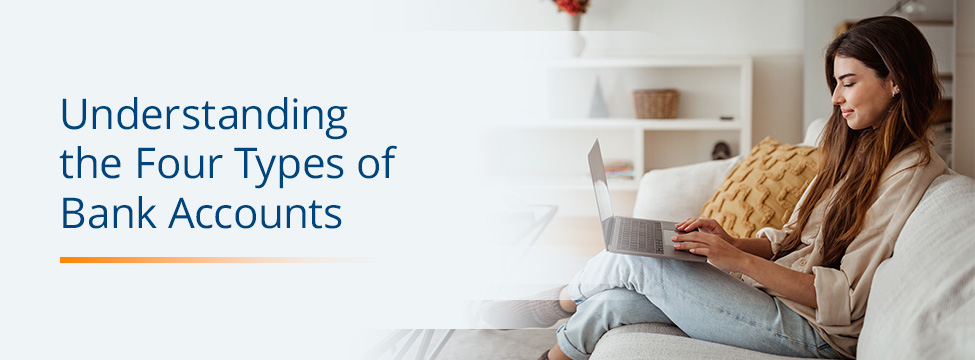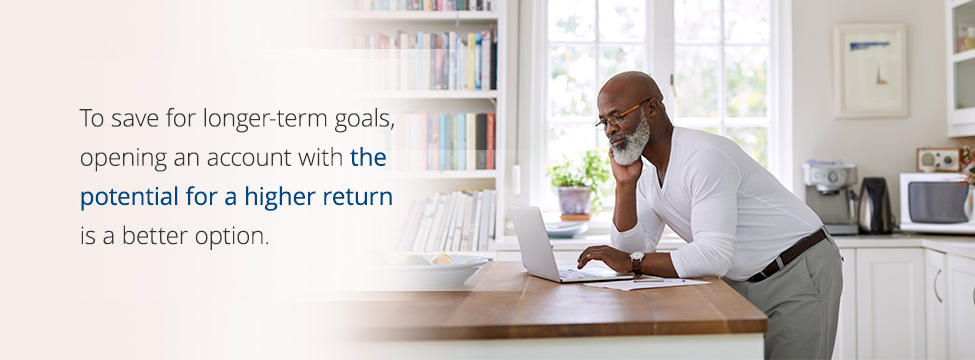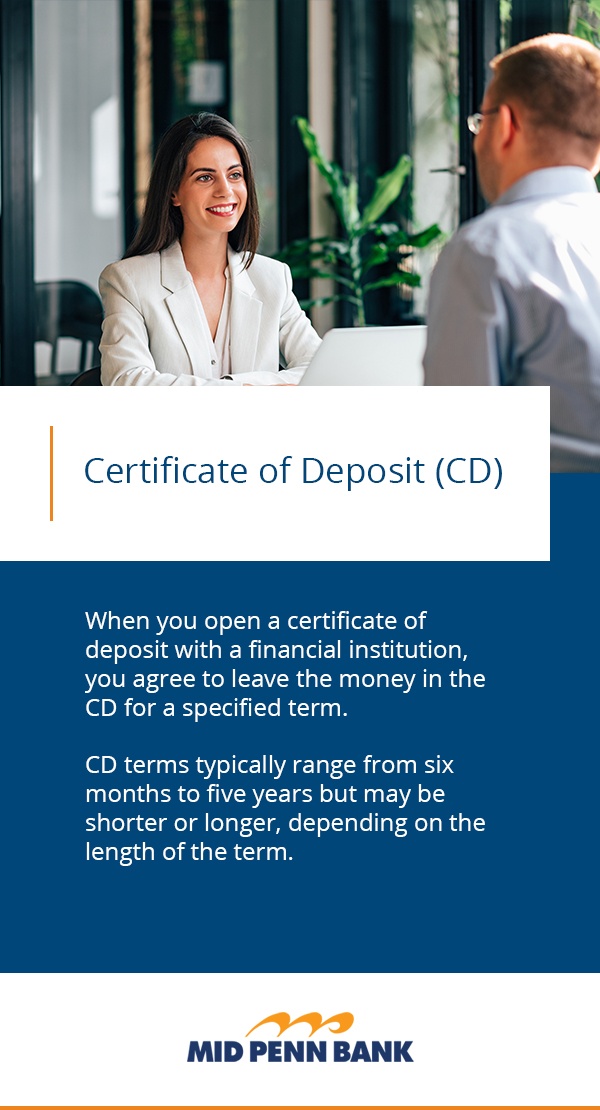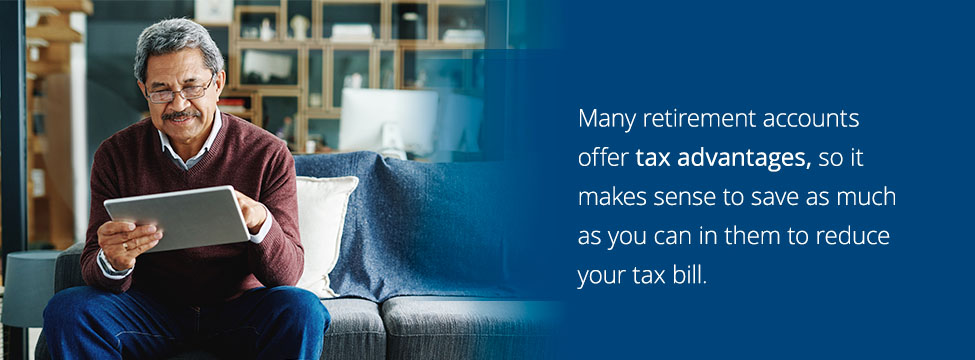Understanding the Four Types of Bank Accounts

Where you decide to put your money plays a significant role in determining your financial security and future. Bank accounts provide a place to securely deposit your cash, allowing you to save for a specific goal or access your money when you need to pay bills. Several types of bank accounts are available. Each one serves a slightly different purpose, and the rules that govern one might not apply to others.
Perhaps you are opening a new account for the first time or want to be more informed about where your money goes. No matter your situation, learn more about the different types of bank accounts and their features below.
What Are Four Types of Bank Accounts?
Generally speaking, you have four options if you decide to open an account at a bank. Some accounts are designed to encourage you to save, while others provide a place to store your money until you need to spend it.
No matter which type of account you choose, look for protection from the Federal Deposit Insurance Corporation (FDIC). The FDIC insures many bank accounts for up to $250,000 per depositor (per bank account category) per bank. FDIC insurance protection means your covered deposits are guaranteed and your money is safe.
From there, you may be able to choose from these types of bank accounts:
1. Checking Account

Think of a checking account as a homebase account that you use to pay your bills and expenses. Usually, the money you deposit into a checking account is there on a short-term basis. You might deposit your paycheck into the account only to withdraw it to buy items, move to savings, pay a credit card, or pay your mortgage and utility bills.
You can deposit money into a checking account in a few ways. Your employer might offer direct deposit, which electronically transfers your salary to the account using the bank’s routing number and the account number. You can also deposit money using paper checks, cash, or electronic transfers.
There are several ways to access funds in the checking account. One of the most common ways to withdraw cash from a checking account is by visiting a teller at the bank or using a debit card at an ATM. Debit cards also work at stores, meaning you can use yours to pay for purchases when shopping in-person or online. You can connect your checking account to peer-to-peer payment apps, such as Zelle®, to make payments to friends and family. When you make a payment with Zelle®, funds are sent electronically and are typically available within minutes.
Mid Penn Bank offers a Simply Free Checking Account that has no monthly maintenance fees and no minimum balance fees. Be aware that some banks charge a monthly fee just for having the account open. Banks may charge a fee for an overdrawn account, the term used when a check is written or transactions are processed and there aren’t enough funds in the account to cover the transaction.
Some of the pros of having a checking account include:
- You can set up automatic payments that make budgeting and paying bills easy. They will automatically process on the due date.
- If you use a budgeting app, you can connect it to your checking account to keep track of expenses. As you spend, it will automatically update your app, saving you the time of having to record the transactions in your app.
- Unlike other accounts, a checking account allows you to make unlimited transactions. Your deposits, purchases, payments, withdrawals, and other transactions are unlimited.
- The cost of opening a checking account is low. Many banks require a minimal deposit, but some may not require one.
- Most banks offer some form of online dashboard where you can keep track of recent activity on your account. Mid Penn Bank’s Online Banking platform takes it one step further and provides an all-in-one tool where you can check your account balances, transfer funds between accounts, and access essential account information at your fingertips.
Like all accounts, there are a few drawbacks to a checking account:
- Some checking accounts pay very little interest, if any at all.
- To keep some accounts open, you’ll have to pay a maintenance fee or service fee every month, or perform some sort of action such as having your paycheck direct deposited every month.
- Make sure to look out for other fees, such as overdraft fees or the charges that come with using another bank’s ATM.
2. Savings Account
A savings account is a place to deposit money you want to accumulate. Savings accounts typically have several features in place to encourage you to leave your money in the account for as long as possible. Many pay interest, meaning the value of the account will grow over time. The amount of interest an account earns will vary based on market conditions and the financial institution. Some banks offer higher interest rates than others.
While the money in a savings account is liquid, meaning you can easily withdraw it, it’s a little less liquid than the money in a checking account since there are no checks provided in a savings account. You can withdraw cash from your savings account using an ATM card, or you can transfer money electronically to and from this account. You can also set up regularly scheduled automatic transfers into and out of your savings account.
While many savings accounts are free, monthly maintenance fees and transfers may be charged to your account. Also, some savings accounts require you to maintain a minimum balance and may charge a fee if the balance falls below a certain threshold. At Mid Penn Bank, our savings accounts have no minimum balance fees, no monthly maintenance charges, and no fees for transfers to other Mid Penn Bank accounts.
Savings accounts can be ideal for money you know you might need eventually, such as an emergency fund or a vacation fund. To save for longer-term goals, opening an account with the potential for a higher return is a better option.

Let’s look at some of the advantages of a savings account:
- A savings account is a good place to store excess cash you don’t need immediately. You can use it to save for financial goals like buying a new car.
- Taking money out of your checking account and putting it into your savings can curb spending.
- By putting your money into a savings account, you can earn interest.
- Even though the number of transactions can be limited, you can still easily access your savings online or via the bank.
Consider the following drawbacks of a savings account:
- Banks sometimes limit the number of withdrawals and transfers you can make from a savings account. However, you can generally make multiple deposits.
- The interest that you earn on your savings account is taxable.
- Some banks may require you to maintain a minimum balance in your savings account.
Start Building Your Savings Today
3. Money Market Account

A money market account is like a savings account with additional features. The interest rate a money market account offers is typically higher than a savings account’s rate. Some banks require a higher minimum deposit in a money market account than in a savings account. A bank might also offer a higher rate to accounts with deposits above a certain threshold and a lower rate to accounts with a balance below that threshold.
Think of a money market account as a hybrid between a checking and savings account. Many accounts include checks or a debit card. Some money market accounts may limit how many checks you can write from the account each month.
If you have a high balance in your savings account, you can open a money market account to earn more interest on your savings. If you’re saving for a down payment on a home, a money market will earn more interest and help you meet your goal faster than a savings account. Otherwise, a standard savings account might be more appropriate for your shorter-term needs.
Consider some of the benefits of a money market account:
- This account generally offers higher interest on larger balances than a standard savings account.
There are also some disadvantages of a money market account:
- Money market accounts do require a larger balance than standard savings accounts in order to earn interest. Most money market accounts require a minimum deposit. However, some require no minimum deposit. It’s important to understand the details and requirements whenever you open your account.
- Some banks limit the transfers and withdrawals you can make on this account.
Start Growing Your Personal Wealth
4. Certificate of Deposit (CD)

When you open a certificate of deposit with a financial institution, you agree to leave the money in the CD for a specified term. CD terms typically range from six months to five years but may be shorter or longer, depending on the length of the term.
In exchange for leaving the money alone for several months or years, a bank will often offer a higher interest rate than is typically available on savings accounts. Often, the longer the CD term, the higher the interest rate.
At the end of the CD term, you have the option of transferring the money, plus any interest earned, to another account. You can also renew the CD for another term. If you renew the CD, the interest rate will usually adjust to the current market rate. It’s possible to get a higher or lower rate at renewal than you had on the original CD.
While CDs are less liquid than savings or money market accounts, you can still access the money in the account if you need it before the term is up. Many banks charge an early withdrawal penalty to discourage people from withdrawing funds before the CD matures or reaches the end of its term. The penalty might be a few months’ worth of interest, which can be significant depending on the account’s value and the current rate.
One way to make CDs more liquid is to start a CD ladder. With a CD ladder, you break up the deposit into smaller chunks. Instead of opening one CD worth $10,000, you open 10 CDs with $1,000 in them. Space the deposits one month or one year apart so each one matures on a different date. You still get the advantage of higher interest rates and get access to your funds if necessary without triggering a penalty.
These are some of the pros of opening a certificate of deposit:
- It’s a great way to store away money for a future goal.
- You can earn higher interest than you would on other accounts.
A certificate of deposit comes with the following cons:
- It isn’t easy to access funds early. You’ll likely pay a penalty if you need to withdraw money before it matures.
- You need a certain amount of money to open one. Most banks require a minimum deposit of $500 to $2,500.
How Many Bank Accounts Should You Have?
Is one bank account enough, or should you have multiple? The answer depends on your overall goals. Many people find that having at least a checking account and a savings account works for them. You can use the checking account for everyday financial transactions and the savings account to set aside money for emergencies or other financial goals. If you’re married or in a long-term relationship, you and your partner might want to have a shared account and separate accounts, too.
People often find that opening several accounts lets them work on and achieve financial goals more easily. If you plan on retiring one day, it makes sense to have a separate retirement account from your emergency savings account. Many retirement accounts offer tax advantages, so it makes sense to save as much as you can in them to reduce your tax bill now and in the future.

In some cases, it makes sense to have several savings accounts at the same financial institution. You might decide to open a money market account to start saving for a down payment on a home. You might have one savings account earmarked for your vacation and another dedicated to your emergency fund.
It is possible to open too many accounts, though. While separating your money based on the goals you’re trying to reach makes sense, things can get too complex. If you work with a financial institution that charges fees for each account, you might end up paying more than necessary to keep several open. A better option might be to consolidate accounts or to work with a bank that offers free accounts.
Learn More About Our Personal Accounts
Learn More About Our Accounts and Services
Choosing the right bank account will depend on your financial needs and goals. Remember, you can open different accounts for different needs. You can have a checking account for your daily transactions and a savings or money market account to help you save for medium and long-term goals.
Mid Penn Bank offers bank accounts, including free checking and savings accounts, to individuals and businesses across Pennsylvania and New Jersey. Whether you’d like to start saving for a rainy day, want a longer-term saving option or need a checking account for everyday expenses, we have accounts for you. Contact us today to learn more or open an account today!
Share:
Disclosures
The material on this site was created for educational purposes. It is not intended to be and should not be treated as legal, tax, investment, accounting, or other professional advice.
Securities and Insurance Products:
NOT A DEPOSIT | NOT FDIC INSURED | NOT BANK GUARANTEED | NOT INSURED BY ANY FEDERAL GOVERNMENT AGENCY | MAY LOSE VALUE

